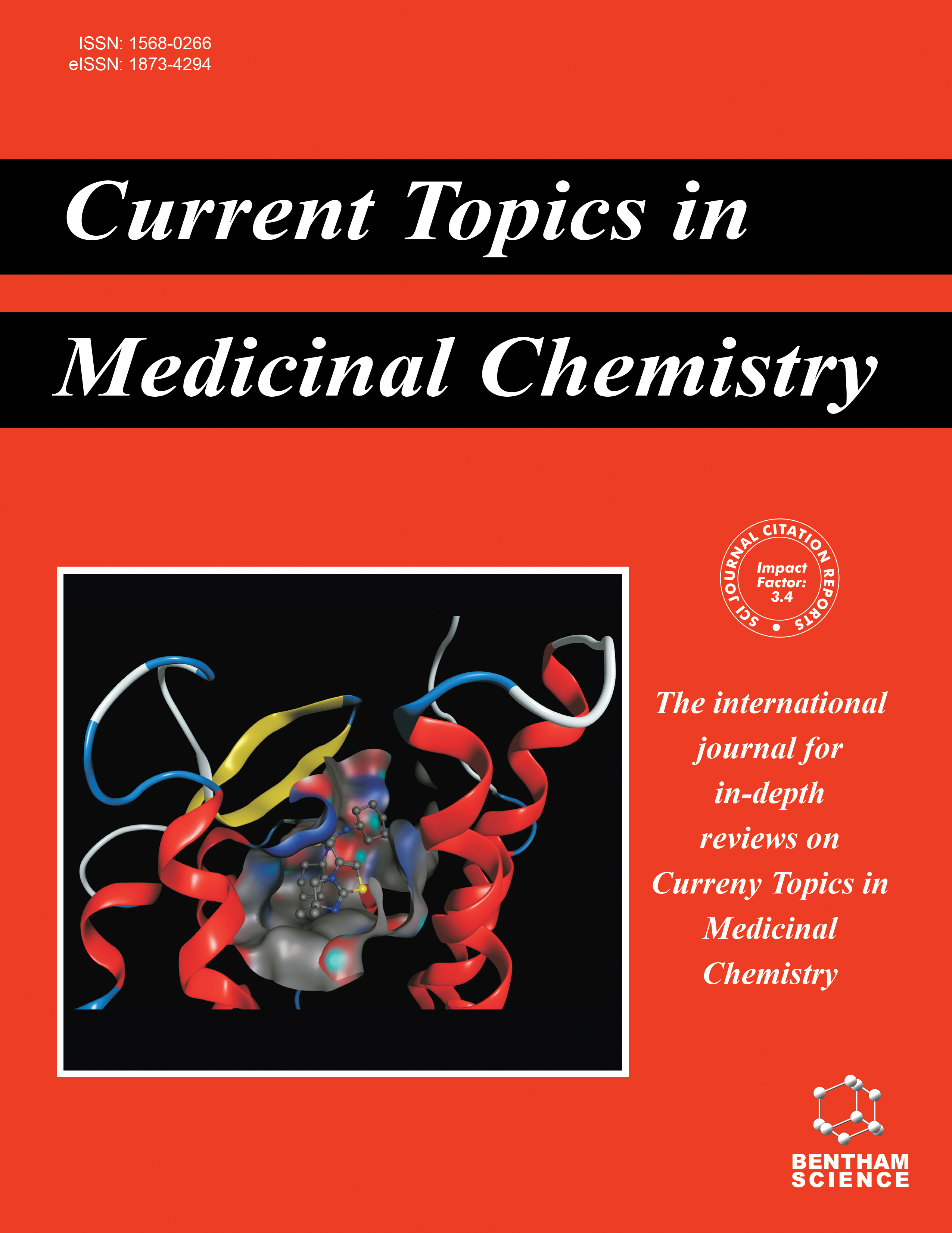- Home
- A-Z Publications
- Current Topics in Medicinal Chemistry
- Previous Issues
- Volume 11, Issue 2, 2011
Current Topics in Medicinal Chemistry - Volume 11, Issue 2, 2011
Volume 11, Issue 2, 2011
-
-
Induced Fit Simulations on Nuclear Receptors
More LessAuthors: Monika Nocker and Pietro CozziniThe large superfamily of nuclear receptors is a family of ligand-activated transcription factors involved in numerous fundamental processes and shows many common characteristics and behaviors. The comprehension of these roles is of fundamental importance to select the right target for receptor structure-based screening. Recently, during the last ten years, several crystallographic structures of nuclear receptors comple Read More
-
-
-
Biochemical and Structural Investigations on Kynurenine Aminotransferase II: An Example of Conformation-Driven Species-Specific Inhibition?
More LessAuthors: Valentina Casazza, Franca Rossi and Menico RizziKynurenic acid (KYNA), one of the metabolites belonging to the kynurenine pathway, has been described as an important neuroprotective compound, its unbalancing being associated with several pathological conditions. In human brain, the majority of KYNA production is sustained by kynurenine aminotransferase II (KAT II). A selective KAT II inhibitor would be an important pharmacological tool, since it would reduce KY Read More
-
-
-
Ligands Turning Around in the Midst of Protein Conformers: The Origin of Ligand-Protein Mating. A NMR View
More LessAuthors: T. A. Pertinhez and A. SpisniProtein-ligand binding is a puzzling process. Many theories have been devised since the pioneering key-and-lock hypothesis based on the idea that both the protein and the ligand have a rigid single conformation. Indeed, molecular motion is the essence of the universe. Consequently, not only proteins are characterized by an extraordinary conformational freedom, but ligands too can fluctuate in a rather vast conformational sp Read More
-
-
-
Accommodating Protein Flexibility for Structure-Based Drug Design
More LessProper incorporation of protein flexibility for prediction of binding poses and affinities of small compounds has attracted increasing attention recently in computational drug design. Various approaches have been proposed to accommodate protein flexibility in the prediction of binding modes and the binding free energy of ligands in an efficient manner. In this review, the significance of incorporating protein flexibility is Read More
-
-
-
Accounting for Induced-Fit Effects in Docking: What is Possible and What is Not?
More LessProteins can undergo a variety of conformational changes upon ligand binding. Although different mechanisms may play a role, the phenomenon is commonly referred to as induced fit to indicate that the tight structural complementarity of the interaction partners is a consequence of the binding event. Docking methods need to take into account this ability of the ligand and the protein to mutually adapt to each other when Read More
-
-
-
Protein Flexibility and Ligand Recognition: Challenges for Molecular Modeling
More LessAuthors: Francesca Spyrakis, Axel BidonChanal, Xavier Barril and F. Javier LuqueThe intrinsic dynamics of macromolecules is an essential property to relate the structure of biomolecular systems with their function in the cell. In the field of ligand-receptor recognition, numerous evidences have revealed the limitations of the lock-and-key theory, and the need to elaborate models that take into account the inherent plasticity of biomolecules, such as the induced-fit model or the existence of an ensemble of p Read More
-
-
-
Thermal Motions of the E. coli Glucose-Galactose Binding Protein Studied Using Well-Sampled Semi-Atomistic Simulations
More LessAuthors: D. J. Cashman, A. B. Mamonov, D. Bhatt and D. M. ZuckermanThe E. coli glucose-galactose chemosensory receptor is a 309 residue, 32 kDa protein consisting of two distinct structural domains. We used two computational methods to examine the protein's thermal fluctuations, including both the large-scale interdomain movements that contribute to the receptor's mechanism of action, as well as smaller-scale motions. We primarily employ extremely fast, “semi-atomistic” Library-Based M Read More
-
-
-
Melatonin-mitochondria Interplay in Health and Disease
More LessAlthough two main hypotheses of mitochondrial origin have been proposed, i.e., the autogenous and the endosymbiotic, only the second is being seriously considered currently. The ‘hydrogen hypothesis’ invokes metabolic symbiosis as the driving force for a symbiotic association between an anaerobic, strictly hydrogen-dependent (the host) and an eubacterium (the symbiont) that was able to respire, but which generated mol Read More
-
-
-
A Closer Look at the High Affinity Benzodiazepine Binding Site on GABAA Receptors
More LessAuthors: Erwin Sigel and Benjamin P. LuscherLigands of the benzodiazepine binding site of the GABAA receptor come in three flavors: positive allosteric modulators, negative allosteric modulators and antagonists all of which can bind with high affinity. The GABAA receptor is a pentameric protein which forms a chloride selective ion channel and ligands of the benzodiazepine binding site stabilize three different conformations of this protein. Classical benzodiazepines e Read More
-
Volumes & issues
-
Volume 25 (2025)
-
Volume 24 (2024)
-
Volume 23 (2023)
-
Volume 22 (2022)
-
Volume 21 (2021)
-
Volume 20 (2020)
-
Volume 19 (2019)
-
Volume 18 (2018)
-
Volume 17 (2017)
-
Volume 16 (2016)
-
Volume 15 (2015)
-
Volume 14 (2014)
-
Volume 13 (2013)
-
Volume 12 (2012)
-
Volume 11 (2011)
-
Volume 10 (2010)
-
Volume 9 (2009)
-
Volume 8 (2008)
-
Volume 7 (2007)
-
Volume 6 (2006)
-
Volume 5 (2005)
-
Volume 4 (2004)
-
Volume 3 (2003)
-
Volume 2 (2002)
-
Volume 1 (2001)
Most Read This Month
Article
content/journals/ctmc
Journal
10
5
false
en


